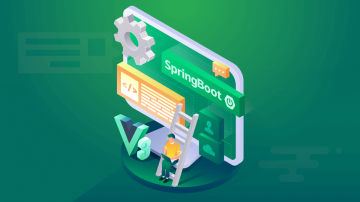我们知道Storm本身是一个独立运行的分布式流式数据处理框架,Springboot也是一个独立运行的web框架。那么如何在Strom框架中集成Springboot使得我们能够在Storm开发中运用Spring的Ioc容器及其他如Spring Jpa等功能呢?我们先来了解以下概念:
Storm主要的三个Component:Topology、Spout、Bolt。Topology作为主进程控制着spout、bolt线程的运行,他们相当于独立运行的容器分布于storm集群中的各个机器节点。
SpringApplication:是配置Spring应用上下文的起点。通过调用SpringApplication.run()方法它将创建ApplicationContext实例,这是我们能够使用Ioc容器的主要BeanFactory。之后Spring将会加载所有单例模式的beans,并启动后台运行的CommandLineRunner beans等。
ApplicationContextAware:这是我们能够在普通Java类中调用Spring容器里的beans的关键接口。

实现原理
Storm框架中的每个Spout和Bolt都相当于独立的应用,Strom在启动spout和bolt时提供了一个open方法(spout)和prepare方法(bolt)。我们可以把初始化Spring应用的操作放在这里,这样可以保证每个spout/bolt应用在后续执行过程中都能获取到Spring的ApplicationContext,有了ApplicationContext实例对象,Spring的所有功能就都能用上了。
Spout.open方法实现
@Overridepublic void open(Map map, TopologyContext topologyContext, SpoutOutputCollector spoutOutputCollector) { //启动Springboot应用
SpringStormApplication.run(); this.map = map; this.topologyContext = topologyContext; this.spoutOutputCollector = spoutOutputCollector;
}Bolt.prepare方法实现
@Overridepublic void prepare(Map map, TopologyContext topologyContext, OutputCollector outputCollector) { //启动Springboot应用
SpringStormApplication.run(); this.map = map; this.topologyContext = topologyContext; this.outputCollector = outputCollector;
}SpringStormApplication启动类
@SpringBootApplication@ComponentScan(value = "com.xxx.storm")public class SpringStormApplication {
/**
* 非工程启动入口,所以不用main方法
* @param args
*/
public static void run(String ...args) {
SpringApplication app = new SpringApplication(SpringStormApplication.class); //我们并不需要web servlet功能,所以设置为WebApplicationType.NONE
app.setWebApplicationType(WebApplicationType.NONE); //忽略掉banner输出
app.setBannerMode(Banner.Mode.OFF); //忽略Spring启动信息日志
app.setLogStartupInfo(false);
app.run(args);
}
}与我们传统的Springboot应用启动入口稍微有点区别,主要禁用了web功能,看下正常的启动方式:
@SpringBootApplication@ComponentScan(value = "com.xxx.web")
public class PlatformApplication { public static void main(String[] args) { SpringApplication.run(PlatformApplication.class, args);
}
}在spout/bolt中调用了SpringStormApplication.run方法后,我们还需要能够拿到ApplicationContext容器对象,这时候我们还需要实现ApplicationContextAware接口,写个工具类BeanUtils:
@Componentpublic class BeanUtils implements ApplicationContextAware { private static ApplicationContext applicationContext = null; @Override
public void setApplicationContext(ApplicationContext applicationContext) throws BeansException { if (BeanUtils.applicationContext == null) {
BeanUtils.applicationContext = applicationContext;
}
}
public static ApplicationContext getApplicationContext() { return applicationContext;
}
public static Object getBean(String name) { return getApplicationContext().getBean(name);
}
public static <T> T getBean(Class<T> clazz) { return getApplicationContext().getBean(clazz);
}
public static <T> T getBean(String name, Class<T> clazz) { return getApplicationContext().getBean(name, clazz);
}
}通过@Component注解使得Spring在启动时能够扫描到该bean,因为BeanUtils实现了ApplicationContextAware接口,Spring会在启动成功时自动调用BeanUtils.setApplicationContext方法,将ApplicationContext对象保存到工具类的静态变量中,之后我们就可以使用BeanUtils.getBean()去获取Spring容器中的bean了。
写个简单例子
在FilterBolt的execute方法中获取Spring bean
@Overridepublic void execute(Tuple tuple) {
FilterService filterService = (FilterService) BeanUtils.getBean("filterService");
filterService.deleteAll();
}定义FilterService类,这时候我们就可以使用Spring的相关注解,自动注入,Spring Jpa等功能了。
@Service("filterService")public class FilterService { @Autowired
UserRepository userRepository;
public void deleteAll() {
userRepository.deleteAll();
}
}将storm应用作为Springboot工程的一个子模块
工程主目录的pom文件还是springboot相关的依赖,在storm子模块中引入storm依赖,这时候启动Strom的topology应用会有一个日志包依赖冲突。
SLF4J: Class path contains multiple SLF4J bindings.SLF4J: Found binding in [jar:file:/Applications/IntelliJ%20IDEA.app/Contents/bin/~/.m2/repository/org/apache/logging/log4j/log4j-slf4j-impl/2.11.1/log4j-slf4j-impl-2.11.1.jar!/org/slf4j/impl/StaticLoggerBinder.class]SLF4J: Found binding in [jar:file:/Applications/IntelliJ%20IDEA.app/Contents/bin/~/.m2/repository/ch/qos/logback/logback-classic/1.2.3/logback-classic-1.2.3.jar!/org/slf4j/impl/StaticLoggerBinder.class]SLF4J: See http://www.slf4j.org/codes.html#multiple_bindings for an explanation.SLF4J: Actual binding is of type [org.apache.logging.slf4j.Log4jLoggerFactory]
我们需要在storm子模块的pom文件中重写org.springframework.boot:spring-boot-starter包依赖,将Springboot的相关日志包排除掉,如下:
<dependency> <groupId>org.springframework.boot</groupId> <artifactId>spring-boot-starter</artifactId> <exclusions> <exclusion> <groupId>org.apache.logging.log4j</groupId> <artifactId>log4j-to-slf4j2</artifactId> </exclusion> <exclusion> <groupId>ch.qos.logback</groupId> <artifactId>logback-classic2</artifactId> </exclusion> </exclusions></dependency>
OK,完美整合!

 随时随地看视频
随时随地看视频





热门评论
-

慕前端39635972018-11-23 0
查看全部评论感觉这个整和没多大意义!storm作业要提交到集群上跑。